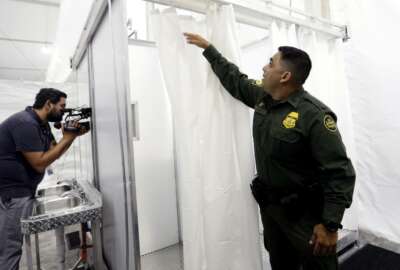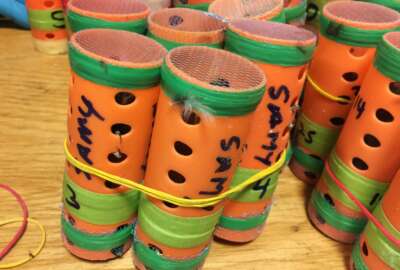Sammies finalist from DHS developed technique for scanning visa applications faster
How can the Department of Homeland Security possibly vet 40,000 people coming to the United States every day to spot the possible security threats?
Best listening experience is on Chrome, Firefox or Safari. Subscribe to Federal Drive’s daily audio interviews on Apple Podcasts or PodcastOne.
How can the Department of Homeland Security possibly vet 40,000 people coming to the United States every day to spot the possible security threats? Until recently, it couldn’t, or it took so long a terrorist could already have moved in. Lori Vislocky developed, in record time and on a shoestring, a modern information system that lets Custom and Border Protection easily screen bad visa applications. She’s technical director in DHS’ Office of Intelligence and Analysis and a finalist in this year’s Service to America Medals program. She joined Federal Drive with Tom Temin for more details.
Interview transcript:
Tom Temin: Ms. Vislocky, good to have you on.
Lori Vislocky: Hi, thank you for having me.
Tom Temin: Well, tell us what you did here exactly, and what problem it was you were solving?
Lori Vislocky: Sure. So the the National Vetting Center, it exists under the Department of Homeland Security. And it’s an essential and frankly, as you noted, a long awaited solution for the government to improve information sharing for the vetting of individuals who are seeking travel or immigration benefits to come to the U.S. Unfortunately, the information sharing that underpins the vetting support has historically been very manual and time consuming, inconsistently applied across different programs where you might have some agencies supporting one program, but not another. So pretty ad hoc as the classified support from the intelligence community was usually formed out of one-off relationships or arrangements. And it’s been heavily focused on counterterrorism threats, versus taking what we consider to be an all-threat view in which we’d want to expand to look at threat actors associated with other other threats like transnational organized crime, counterintelligence, and so on. So the government was missing kind of that single coordinating entity to address these issues and ensure that those who are responsible for reviewing applicants who are looking for entry to the U.S., making sure that they have the information they need, when they need it, from those national security partners, and the intel community. So the NVC was created to solve these problems. And when we talk about the National Vetting Center, it’s not like a brick-and-mortar center that you might think of, in terms of like the Terrorist Screening Center or National Counterterrorism Center. It’s very much like a virtual and technical solution here, where we provide a technology platform and process that allows for a coordinated and comprehensive review of the information adapts associated with that applicant that’s applying for the travel to come here, immigration benefit.
Tom Temin: Sure. It sounds like you had to bring together quite a number of databases and normalize them so that they can be accessed in one place. Was that the chief challenge here?
Lori Vislocky: Yes, absolutely. The systems integration work that we do is incredibly complex. It ends up being at least six different agencies that are involved more for some of the other programs that we’re working. And so as you can imagine, each of those are coming to the table with different systems, different technology, different resourcing that they can bring to bear; different agency cultures that they’re bringing forward, different historical perspective. And so getting everyone kind of moving together, building consensus is quite a feat in and of itself. And, I’ve been really proud of our teams and how they’ve been able to come together to develop new capabilities to make smart process and design decisions and do so under some really high pressure situations where the administration is looking to us to achieve its goals on their timelines, like you mentioned before at the intro of this being stood up in a really short amount of time.
Tom Temin: And in supporting this mission, how did you get this done? Did you do programming within the team itself? Did you have contractor support? And was it done in an agile way so that the people that were going to use the system could kind of keep abreast of what you were doing step by step?
Lori Vislocky: Yep, absolutely. So we do have a mix of contract support and federal employees supporting it. So when we first went live, we had to really assess what we had available to us. At the time, since we had to deploy this in such a short timeframe. We didn’t necessarily want to start from scratch or kind of recreate the wheel. So we had to kind of look across the capabilities that already existed in our community and see what could be easily adapted or modified to support this, and throughout that kind of always keeping an eye on the future. Right, like we have to very short term deadlines that we needed to deliver on. But always in our design decisions, making sure that we weren’t boxing ourselves into a corner, where there’d be something that we couldn’t undo in the future for a different program. So, always trying to keep an eye on that, like reuse and reuse ability, and just bringing forward that thought diversity, making sure that we’re accounting for different scenarios and different edge cases so that in the end, we’re ultimately providing to those customers, a robust solution that meets their needs.
Tom Temin: We’re speaking with Lori Vislocky. She’s technical director in the DHS Office of Intelligence and Analysis and a finalist in this year’s Service to America Medals Program. And how did you come to this work? Your technical director is your title now, when you’re talking about agile development and contractor support, yet you were actually an intelligence analyst and you looked at Al-Qaeda and things like that before?
Lori Vislocky: Yeah, that’s right. It’s not something that I ever really planned for myself. But I guess looking back, it actually, piecing it together makes quite a bit of sense. And so as you notice, I was working as an intel analyst, looking at Al-Qaeda and other Pakistan-based militant groups. But in that role, I wasn’t just looking at their capabilities overseas, I was really looking at it through the lens of, how could they exploit our travel and immigration system to gain entry or like carry out an attack here in the homeland. So I was regularly working with the department’s travel and immigration databases. And so as an analyst, I knew firsthand the pain points or the limitations that occur, because the department has collected and stored all of its data on the individuals that it encounters, whether it’s travelers or visa applicants, that all lives on one network – an unclassified network. And we didn’t have a systematic way to compare it against foreign intelligence information that our intel community partners had collected and maintained on the classified information. So it was, it’s not just that you had information stovepiped in different databases. It lived on completely different infrastructure on completely separate networks. And so I actually ended up transitioning and getting involved in some of the department’s big data initiatives that were aimed at building out new technology to bridge that gap and overcome that problem, so that we can make it easier to compare the unclassified with the classified information. I actually converted to federal service in 2015. Prior to that, I was working as a consultant for DHS I&A, and ended up converting to having some decision-making authority and being able to take ownership of those big data initiatives in order to drive them forward. So when the department started, early conversations around implementing the vetting center, I actually had already been piloting capabilities that were candidates for those technical solutions. So it made for a natural and really organic partnership with the work that I’ve been doing at DHS I&A and actually, in coordination with Customs and Border Protection, which now administers the vetting center on behalf of the department and the U.S. government, I guess it’s really been like a labor of love. I’m a problem solver by nature. And there’s always some new challenge, some new puzzle to figure out. So it’s been really satisfying and fulfilling to punch through that.
Tom Temin: And we should point out that you are 35 years old, and so in many ways you are punching above your age, so to speak, because there are lots of CIOs that have tried to do that systems integration job, and sometimes in five years, they can’t get it finished. So what’s the secret here?
Lori Vislocky: Well, I think the main thing that I bring to the table is my ability to translate the complex mission policy and legal requirements into a real world tech solution. And so that’s where my background as an analyst really plays to my strengths here. So, you know, in my experience, those different functional teams are speaking different language and struggle to speak one another. So I’m able to sit down with our customers, the operators and the lawyers and the privacy professionals. And just given that experience I’ve had up until now, I can speak to each of them in their own language and then, take their input and and come up with a technical solution that satisfies all of them.
Tom Temin: Lori Vislocky is technical director in the DHS Office of Intelligence Analysis, and a finalist in this year’s Service to America Medals Program. Thanks so much for joining me.
Lori Vislocky: Thank you, Tom. It’s great to have been here.
Copyright © 2025 Federal News Network. All rights reserved. This website is not intended for users located within the European Economic Area.
Tom Temin is host of the Federal Drive and has been providing insight on federal technology and management issues for more than 30 years.
Follow @tteminWFED






